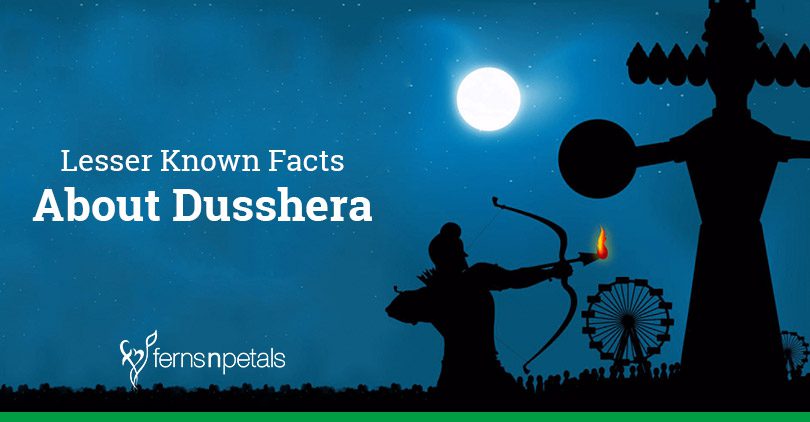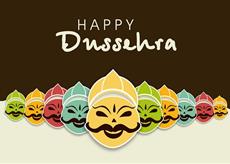We all know thoroughly what Dusshera is and why it is celebrated. In ancient times Lord Rama killed Ravana and to honor that victory, in the present times, an effigy of Ravana is burnt. Since India is a land of cultural diversity so there never is one story behind a festival! In West Bengal, it is believed that Goddess Durga killed a cruel demon named, Mahishasura and to mark that, Durga Pujo is celebrated. There are many tales associated with this festival and in various parts of India people celebrate this festival for various reasons. But the basic message of this festival is – victory of good over evil. We all are reminded of these interesting tales so that we imbibe good qualities in us and always remain good. However there are many myths, tales, fables, stories, facts etc. which you might have not heard of!
Take a look below and check how many out of these 9 trivial facts you didn’t know about Dusshera:-
The Sun Might Have not Risen– First let’s clear the etymology of this name Dusshera. Dusshera comes from two Sanskrit words, Dasha and Hara meaning Sun and Defeat respectively. The thunderous activities of demon Ravana was at its height and there was a belief that if he is not killed, the sun won’t rise. Lord Rama had to defeat Ravana and the sun rose with glory.
The Fight for Immortality– As per Puranas, old scriptures, we come to know that the whiz Mahishasura wanted immortality and that’s why was engaged in praying to Lord Brahma. Lord Brahma was impressed and granted him immortality. But he took this blessing in a bad light and started taking all other demons under his patronage and advised all of them to create a chaos and havoc on the Earth. These asuras or demons became so powerful that they also defeated the Gods. All gods went to meet Lord Brahma and he then called upon Lord Vishnu and Lord Shiva for a meeting.
These three gods then decided to create the most powerful woman of this universe named Devi Durga. She would be created with all the energies of these three gods – Brahma, Vishnu, and Shiva. So, Devi Durga started fighting with Mahishasur and this war went for 9 prolonged days and nights.On the tenth day, Mahishasura was finally killed. So, now the question may arise if Mahishasura was granted immortality, how can someone kill him? The real story is that Lord Brahma being the lord of the lord’s played a clever game. He granted him immortality but also said that only a woman can kill him. Subjugating the power of a woman, Ravana started thinking that he is really immortal.
Ten Things We Hate– We all have good and bad qualities inside us. We are a representation of the qualities we have nurtured, may be good or bad. Ravana is also known as Dashanana and this name means someone who has ten heads (Dash – ten; Anana – head). Each of these ten heads refer to ten bad qualities and they are: Kamavasana – Lust; Krodha – Anger; Moh – Attachment; Lobh – Greed; Mada – Pride; Matsara – Jealousy; Swartha – Selfishness; Anyaaya – Injustice; Amanavata – Inhuman or Cruelty; and Ahankara – Ego. When the effigy of Ravana is burnt down, one’s soul is also cleansed from these ten ruining qualities.
The Homecoming– In some stories, it is said that Goddess Durga along her children Lakshmi, Ganesha, Karthik, and Saraswati comes to her birthplace, i.e., earth and stays for some time. On the Vijaya Dashami day, she returns to Kailash to her husband Lord Shiva. In many communities, this is why all the married or unmarried women of the family returns home.
No Boundaries of Celebration– Apart from India, Nepal, Bangladesh, Sri Lanka, and Malaysia also celebrates this festival with great enthusiasm. As Indians are settled in almost all major places of the world, we also see Durgotsav in London, Los Angeles, Sydney, etc.
The D-Day of Asura– The last day of the festival is named “Vijaya Dashami” and that means victory achieved on the 10th day of the lunar calendar. Vijaya means victory while Dashami is referred to the 10th day of the lunar calendar. On this day, Devi Durga defeated the cruel Mahishasura.
Upscaling Dusshera– So, since when this tradition of large scale celebration of Dusshera started? It begun in the 17th century in Mysore because the king of Mysore ordered his people to celebrate this festival with great enthusiasm. That’s how it spread all across the country. Today we see so much money incurred for pandals, lights, floral decoration, and live performances of bands or individual singers.
Change of Season– The onset of winter season is marked by this festival. The scorching-sultry summer and the dark-gloomy monsoon says a bye and a cool-pleasant winter arrives. So, the harvesting also changes from Kharif to Rabi.
How Rama Met Durga– In the beginning we said that mostly people believe that this festival is celebrated in honor of Lord Rama or Goddess Durga. Lord Rama performed the Chandi Homa Yajna to take blessings form Devi Durga before killing the demon Ravana. Devi Durga granted Lord Rama a boon and also shared some tips on how to kill Ravana.
It is important to learn the true meaning behind festivals and why they are celebrated. Dusshera is an important Indian festival. Celebrate Dusshera with your near and dear ones and send them cool gifts online.








